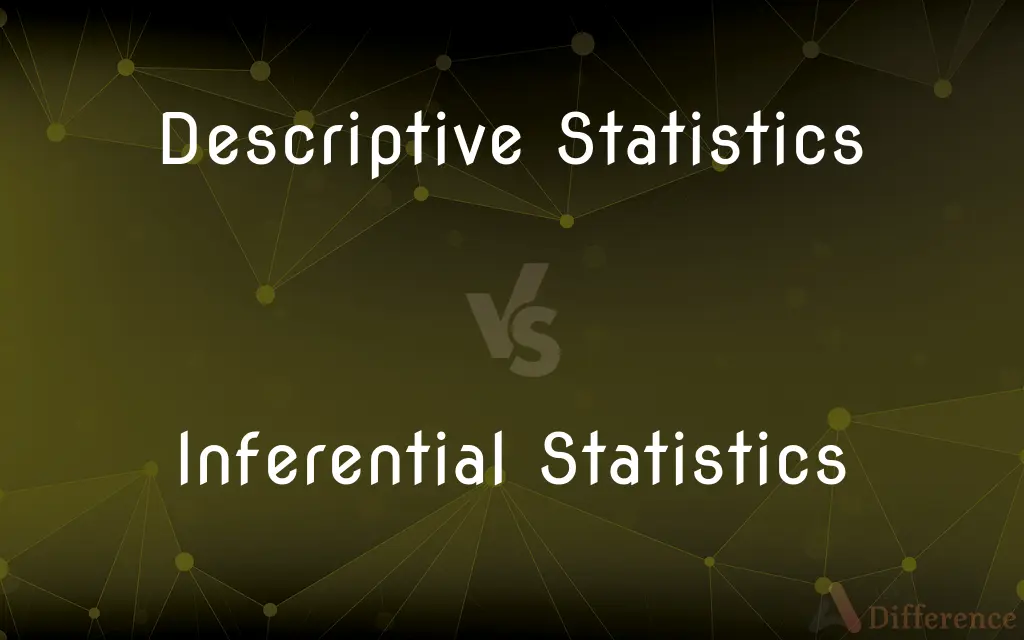Descriptive Statistics vs. Inferential Statistics — What's the Difference?
Edited by Tayyaba Rehman — By Fiza Rafique — Published on December 27, 2023
Descriptive Statistics summarize data sets; Inferential Statistics make predictions based on those data sets.

Difference Between Descriptive Statistics and Inferential Statistics
Table of Contents
ADVERTISEMENT
Key Differences
Descriptive Statistics provide a snapshot of main aspects in a dataset, like mean or standard deviation. In contrast, Inferential Statistics use a sample from the population to draw conclusions about the population.
While Descriptive Statistics give a detailed understanding of specific characteristics within the data, Inferential Statistics allow for hypotheses testing and identifying patterns to make predictions.
Descriptive Statistics help in understanding the central tendency, variability, and distribution of data. Inferential Statistics, on the other hand, make estimations about populations based on sample data.
Measures such as average, median, and mode fall under Descriptive Statistics. Whereas, tools like regression analysis, t-tests, and chi-square tests belong to Inferential Statistics.
In essence, Descriptive Statistics lays out the features of data, painting a clear picture. Conversely, Inferential Statistics delves deeper, making projections and determinations beyond the immediate data.
ADVERTISEMENT
Comparison Chart
Purpose
Summarize data
Make predictions based on data
Examples
Mean, Median, Mode
T-test, Regression analysis
Deals with
Data at hand
Predictions about population based on samples
Application
Initial data analysis
Hypothesis testing
Outcome
Clear picture of data
Determinations and projections about data
Compare with Definitions
Descriptive Statistics
Tools that showcase data patterns.
Descriptive Statistics showed a positive skewness in the income dataset.
Inferential Statistics
Methods to identify patterns and relationships.
Inferential Statistics were employed to discern if age affects buying habits.
Descriptive Statistics
Data summarization tools.
Using Descriptive Statistics, we found the average age of the participants was 30.
Inferential Statistics
Methods to estimate population parameters.
Through Inferential Statistics, we estimated the average city income.
Descriptive Statistics
Measures of central tendency.
The Descriptive Statistics revealed most students scored around the median mark.
Inferential Statistics
Predictive tools based on samples.
Inferential Statistics suggested a likely increase in sales next quarter.
Descriptive Statistics
Methods to detail specific dataset characteristics.
Using Descriptive Statistics, we observed a tight range in height measurements.
Inferential Statistics
Hypothesis testing procedures.
We used Inferential Statistics to determine if the new drug was effective.
Descriptive Statistics
Overview of dataset features.
Descriptive Statistics provided a variance value, indicating the spread of scores.
Inferential Statistics
Tools to make conclusions from samples.
Inferential Statistics showed a probable correlation between diet and recovery time.
Common Curiosities
What's the primary aim of Inferential Statistics?
To make predictions or inferences about a population based on a sample.
What do Descriptive Statistics mainly deal with?
They deal with summarizing and describing a dataset.
Which statistics can give information on data spread?
Descriptive Statistics like range, variance, and standard deviation provide such information.
Which statistic would be used to test a hypothesis?
Inferential Statistics would be used for hypothesis testing.
In research, why are Inferential Statistics essential?
They allow researchers to make predictions and generalizations beyond the sample studied.
Can you give an example of Descriptive Statistics?
Yes, the mean (average) of a data set is a Descriptive Statistic.
Are Descriptive Statistics necessary before Inferential Statistics?
Typically, yes. They provide a foundation and understanding of the data before making inferences.
Does Inferential Statistics always provide accurate predictions?
Not always. They provide estimations with a certain level of confidence.
How do Descriptive Statistics assist in initial data analysis?
They provide a clear overview of main aspects, aiding in understanding data's nature and structure.
What kind of tools or tests are part of Inferential Statistics?
Tools like chi-square tests, regression analysis, and t-tests are part of Inferential Statistics.
Share Your Discovery

Previous Comparison
d Block Elements vs. f Block Elements
Next Comparison
Mechanical Engineering vs. Automotive EngineeringAuthor Spotlight
Written by
Fiza RafiqueFiza Rafique is a skilled content writer at AskDifference.com, where she meticulously refines and enhances written pieces. Drawing from her vast editorial expertise, Fiza ensures clarity, accuracy, and precision in every article. Passionate about language, she continually seeks to elevate the quality of content for readers worldwide.
Edited by
Tayyaba RehmanTayyaba Rehman is a distinguished writer, currently serving as a primary contributor to askdifference.com. As a researcher in semantics and etymology, Tayyaba's passion for the complexity of languages and their distinctions has found a perfect home on the platform. Tayyaba delves into the intricacies of language, distinguishing between commonly confused words and phrases, thereby providing clarity for readers worldwide.
















































